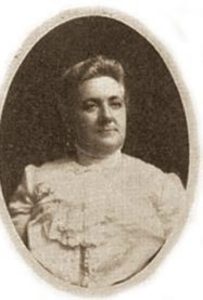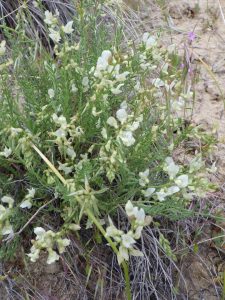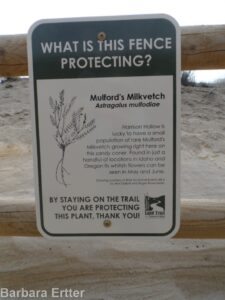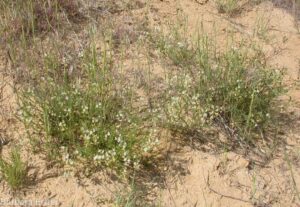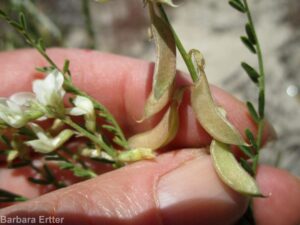Mulford’s Milkvetch (Astragalus mulfordiae), one of Idaho’s rarest plants that is currently in peak bloom in the Boise Front, comes with a wonderful back-story involving a woman who was both one of the earliest plant collectors in the young state of Idaho and also the first student to obtain a Ph.D. from the joint doctoral program between Washington University and Missouri Botanical Garden in St. Louis. This was Dr. Anna Isabel Mulford, with the following biography based on a combination of decades-long sleuthing by my colleague Carol Prentice and a recent on-line biography by Cassidy Moody.
Carol’s interest was piqued in 1979, when Dr. Patricia Packard mentioned that no one in Idaho knew who Astragalus mulfordiae was named for. The “-iae” ending was a clue that the species was named for a woman (the ending would have been “-ii” if named for a man), but Carol didn’t know this at the time. It therefore came as a surprise to learn that Marcus E. Jones, who formally described the species in 1898, named it honor of a woman who had first collected it in Idaho. This led Carol to track down a separate publication by Mulford herself, describing her travels to the wild West in 1892, and several of the plants she found during her visit. This was all before the internet, adding to Carol’s challenge of tracking down the relevant publications and other sources.
Mulford’s article, published in 1894 in the Botanical Gazette, begins with “In the summer of 1892 I made a very interesting trip in the northwest. The months of June, July and August were spent in Idaho. My work in the state was done in the sage brush of the southern part, in the Owyhee mountains to the southwest, and in the highlands, foothills and mountains of the eastern portions. I traveled by railroad to the principal points, and by stage, carriage, or horseback to more distant ones. Of course I walked a good deal. I was well provided with letters of introduction, and there was seldom any difficulty in procuring company whenever desirable, which was necessarily a great part of the time.”
Among the letters of introduction was evidently one that led to Mary Hallock Foote, well-known locally for her writings and illustrations that capture an early era of Boise’s history. Foote’s memoirs, posthumously published as A Victorian Gentlewoman in the Far West, describe the travails experienced by the family as her husband, Arthur Foote, pursued various engineering schemes (including what would eventually become the New York Canal) in the western United States and Mexico. The memoirs also provided inspiration, and fodder, for Wallace Stegner’s controversial Angle of Repose.
Mulford’s interaction with Foote is documented by one of the several species that Mulford described from her time in Idaho, Scutellaria footeana. “This was found at about 3,500 ft near Black Cañon, Boise River, June 18th. I have named the plant in honor of Mrs. Mary Hallock Foote, who planned, and accompanied me upon the pleasant expedition which led to its discovery.” The specific reference to the Boise River makes the basalt-rimmed stretch of the river east of Boise the probable site of Mulford’s “Black Cañon,” and it would have made perfect sense for Foote to take her visitor botanizing in the area where the Foote family had lived for several years.
Alas, Foote’s botanical claim to fame was short-lived, with Scutellaria footeana soon disappearing into the synonymy of the relatively widespread Scutellaria nana. Three other plants described by Mulford in the same publication have likewise been absorbed by previously named species: Oenothera idahoensis into O. caespitosa ssp. marginata, Frasera caerulea into F. albicaulis var. cusickii, and Gilia grandiflora var. diffusa into an undifferentiated Collomia grandiflora. The only species Mulford described from Idaho that has stood the test of time is Frasera montana, whose lovely white blooms grace the mountains of central Idaho.
Somewhat surprisingly, Mulford was already 44 years old at the time of her Idaho excursion, six years after taking a post-graduate course at Vassar College that qualified her to be a professor of botany. She eventually went on to obtain a Ph.D. at Washington University in 1895, age 47. Her doctoral dissertation was on the genus Agave, working with Garden director William Trelease. Although this choice of topic leaves unanswered the impetus for her collecting trip to Idaho, it did create an opportunity for her to interact with another early Idaho collector, Timothy E. Wilcox, who had been Assistant Surgeon at Fort Boise from 1879 to 1882. At the time of Mulford’s doctoral research, Wilcox was posted at Fort Huachuca in southern Arizona, where Agave was abundant. Mulford credits Wilcox with assistance and for photos, specifically noting the value of his “habit photos,” and also quotes Wilcox describing which species of agave that cows will eat in Arizona.
Little is known of Mulford’s early years, other than growing up in East Orange, New Jersey, and attending Trenton Normal School (now The College of New Jersey). Obituaries indicate that her father, Timothy Mulford, was a wheelwright who “manufactured wheels used by Union forces in the Civil War.” After obtaining her Ph.D., Mulford had a long teaching career, including high schools in St. Louis (and possibly Wake Forest University in North Carolina). Census records show that she had moved back home to East Orange by 1930. She evidently never married, retaining her maiden name at the time of her death in 1943, age 95.
Astragalus mulfordiae is one of three species named after Isabel Mulford, and the only one still in active use. The other two are Agave mulfordiana Trelease (now a synonym of A. schottii) and Viola mulfordiae Pollard (now used for the hybrid of V. brittoniana × V. sagittata).
Mulford’s milkvetch is endemic to the western Snake River Plain in southwestern Idaho and adjacent Oregon, restricted to loose, sandy substrates of former Lake Idaho sediments. It has an S2/Imperiled conservation status in Idaho, due to the ongoing loss and habitat degradation of its scattered populations from development, invasion by cheatgrass and other non-natives, and careless recreation. Federal protection would easily be warranted if this species were a mammal or bird, but the abundance of plants with equivalent status would overwhelm an already overloaded system out of favor with competing agendas. If the decline of this delicate species is not reversed, we will lose not only one of the special plants that still grace the Boise Front, but also a tangible tie to an intrepid woman who is also nearly forgotten.
Mulford, A. Isabel. 1894. Notes upon the northwestern and Rocky Mountain flora. Botanical Gazette 19: 117-120.
Mulford, A. I. 1895. A Study of the Agaves of the United States. Missouri Botanical Garden Annual Report 7: 47-100.
